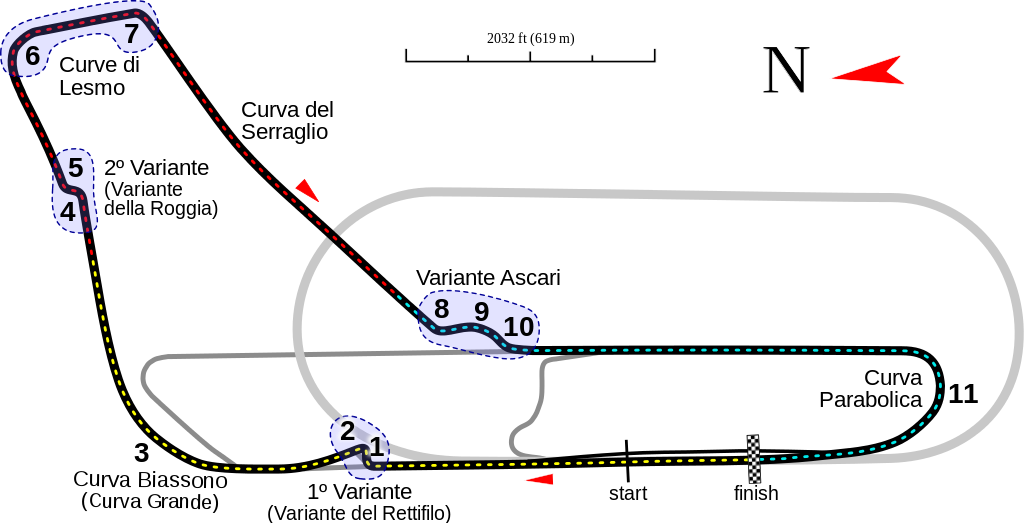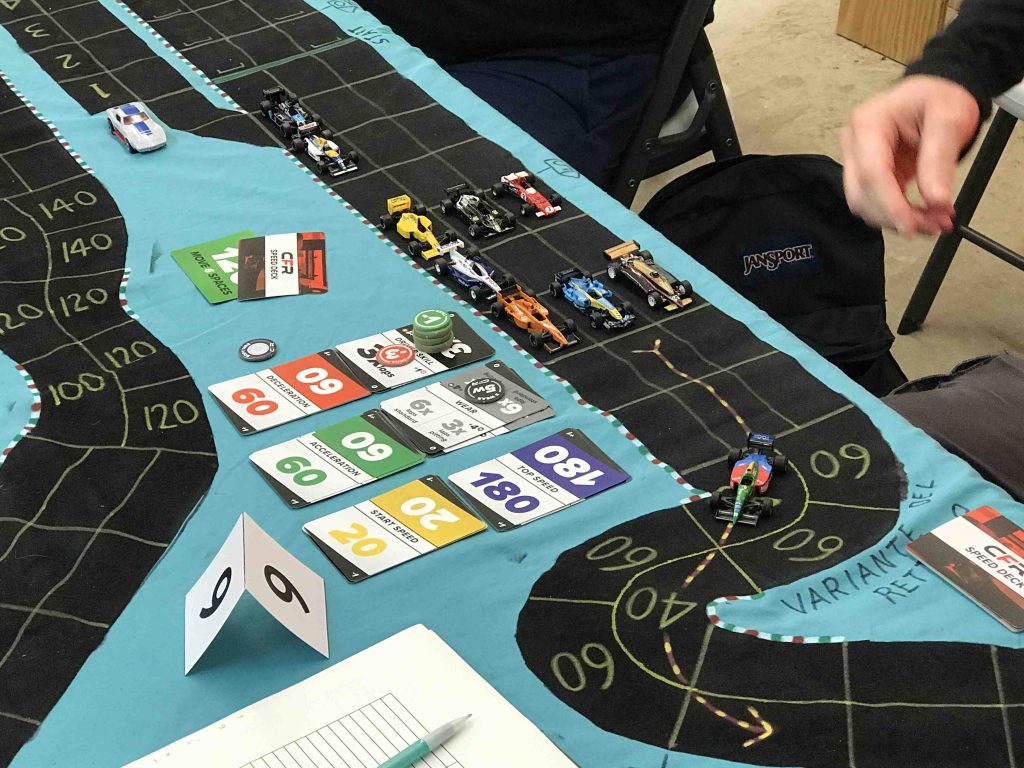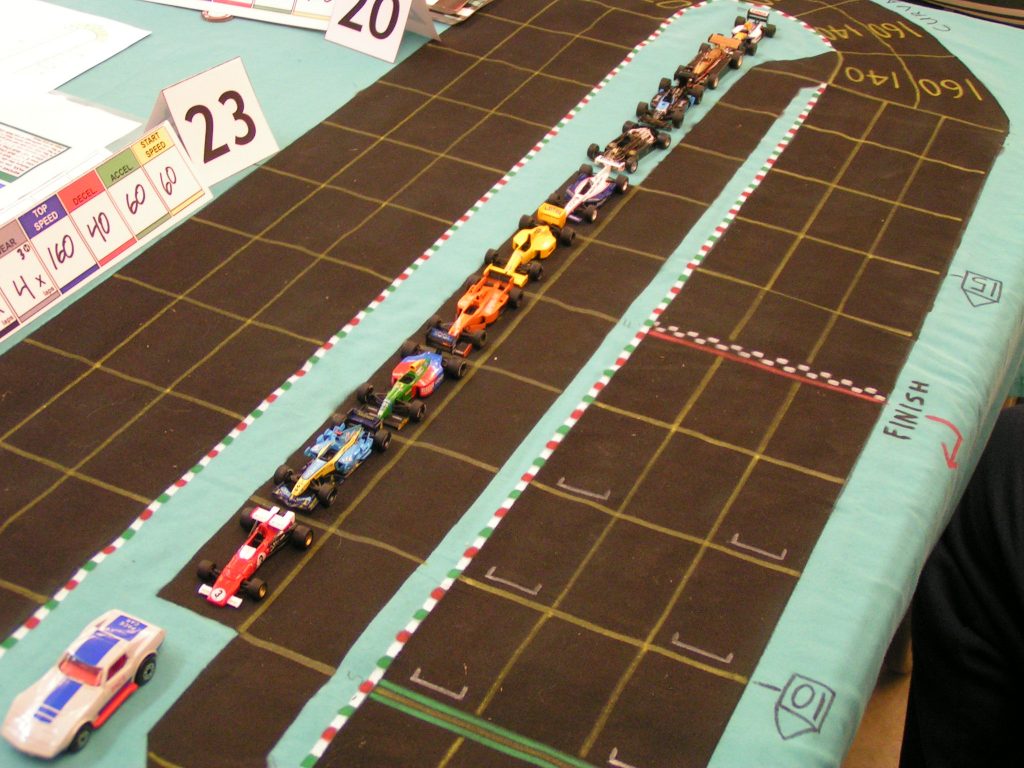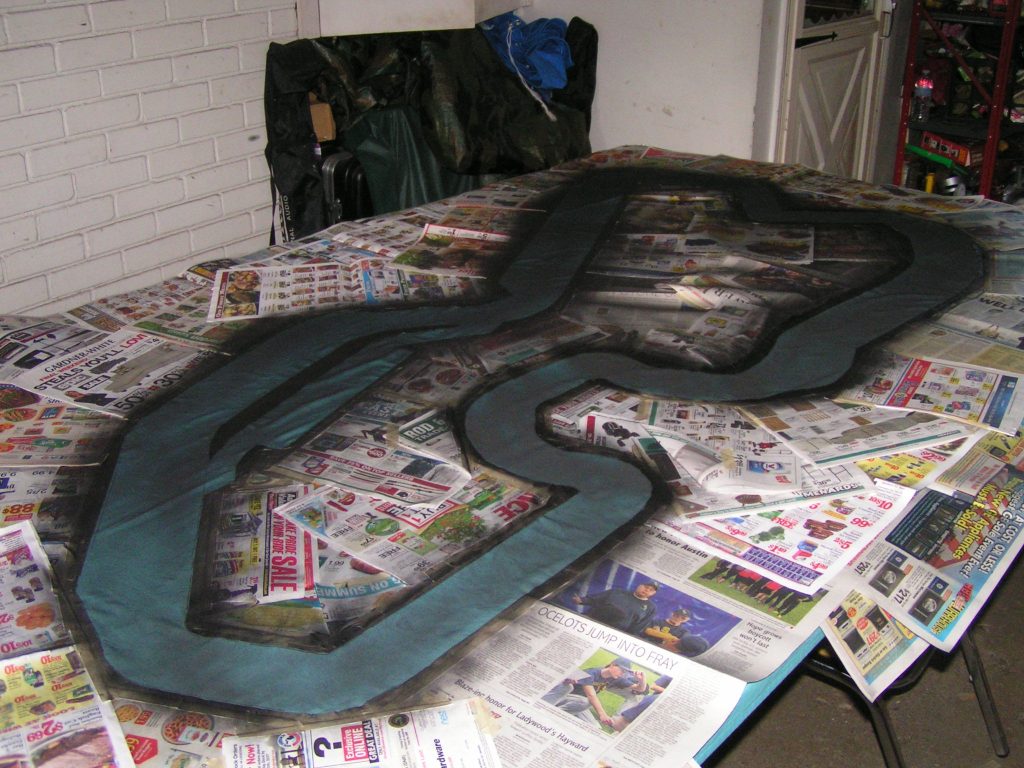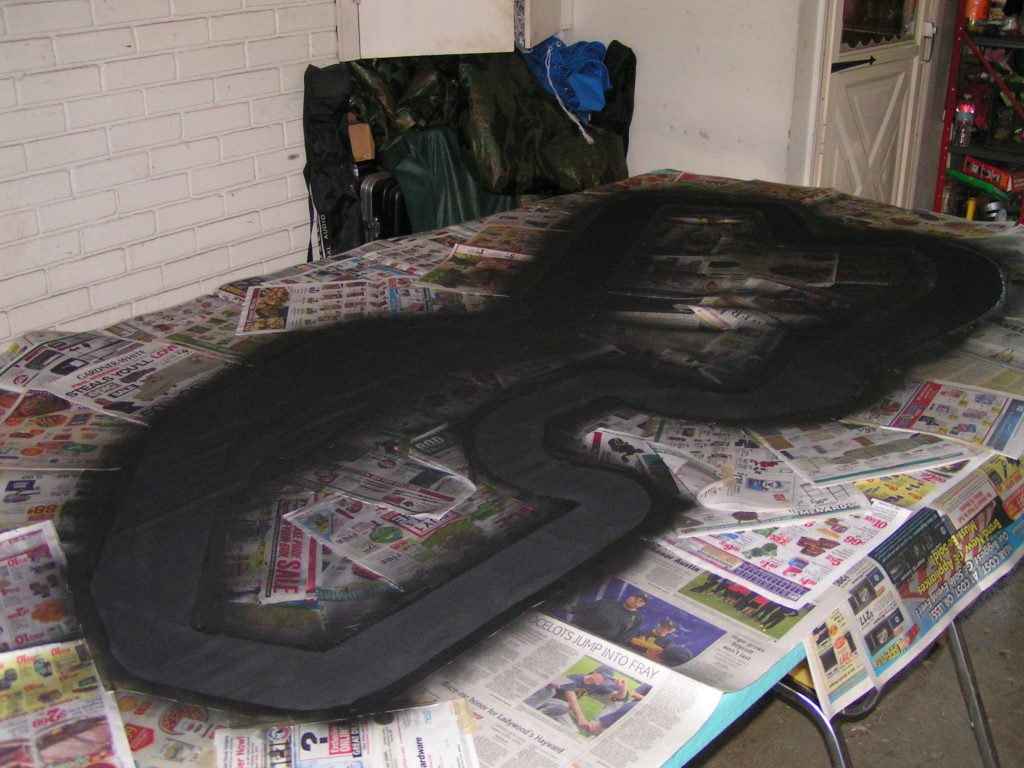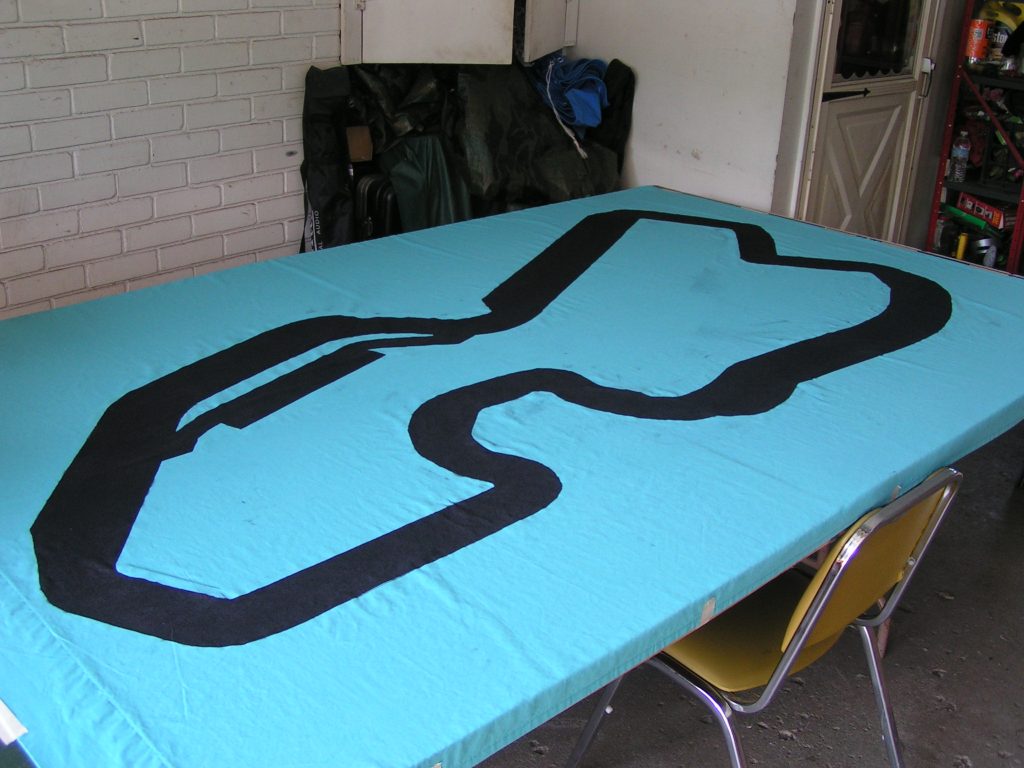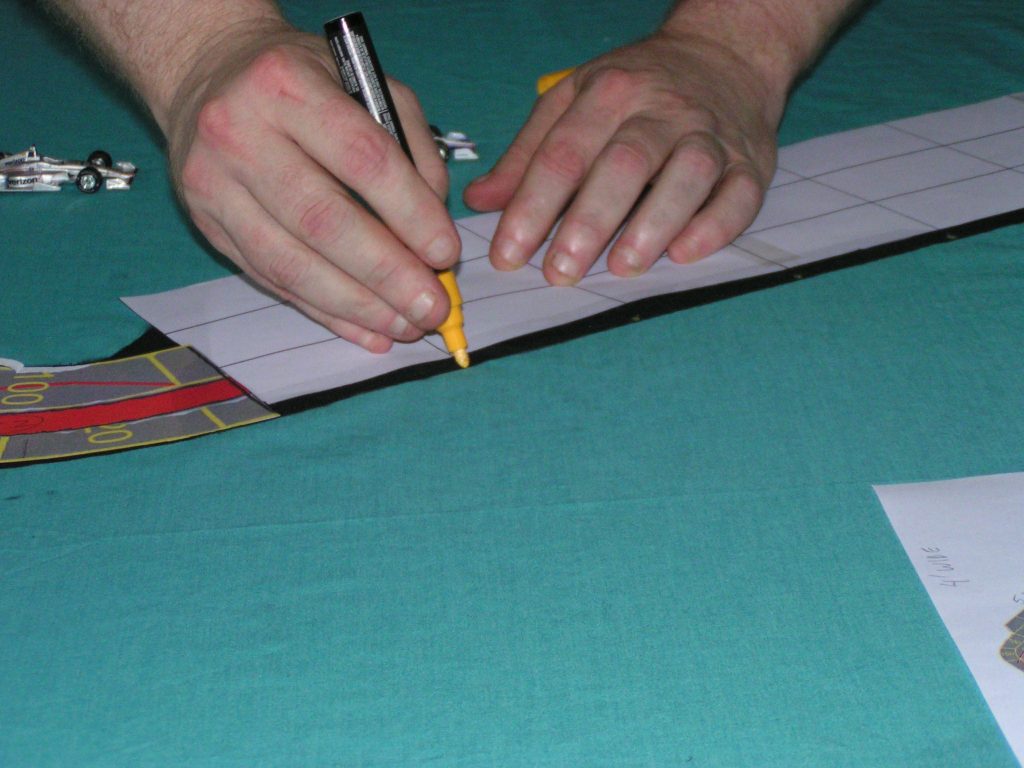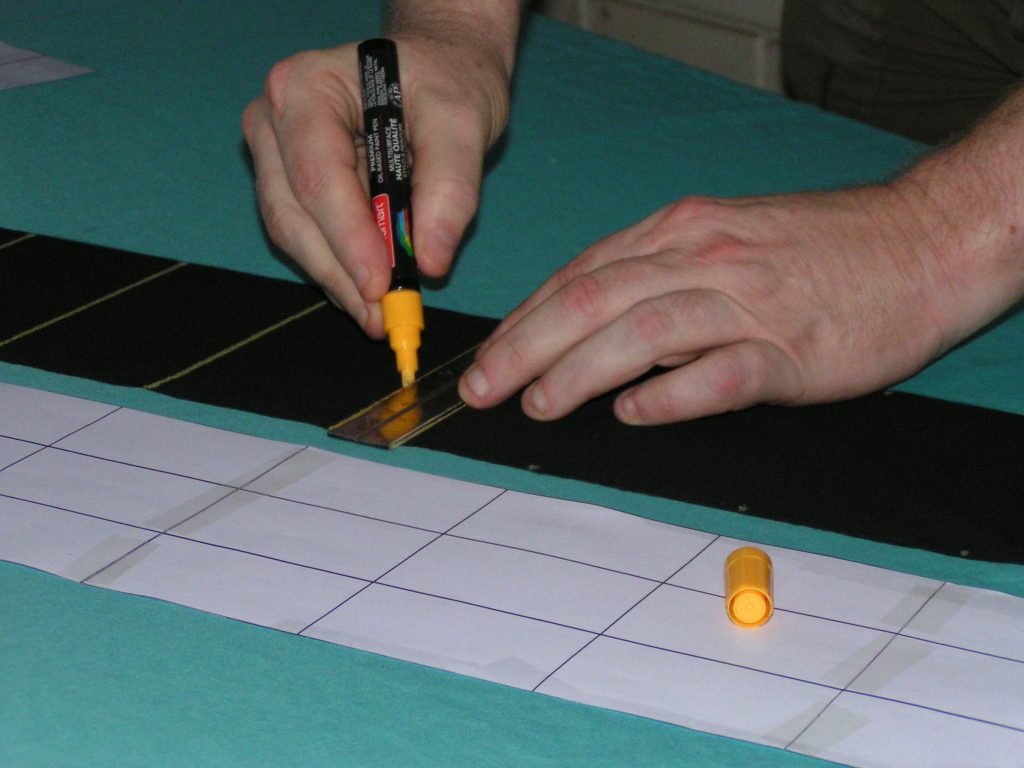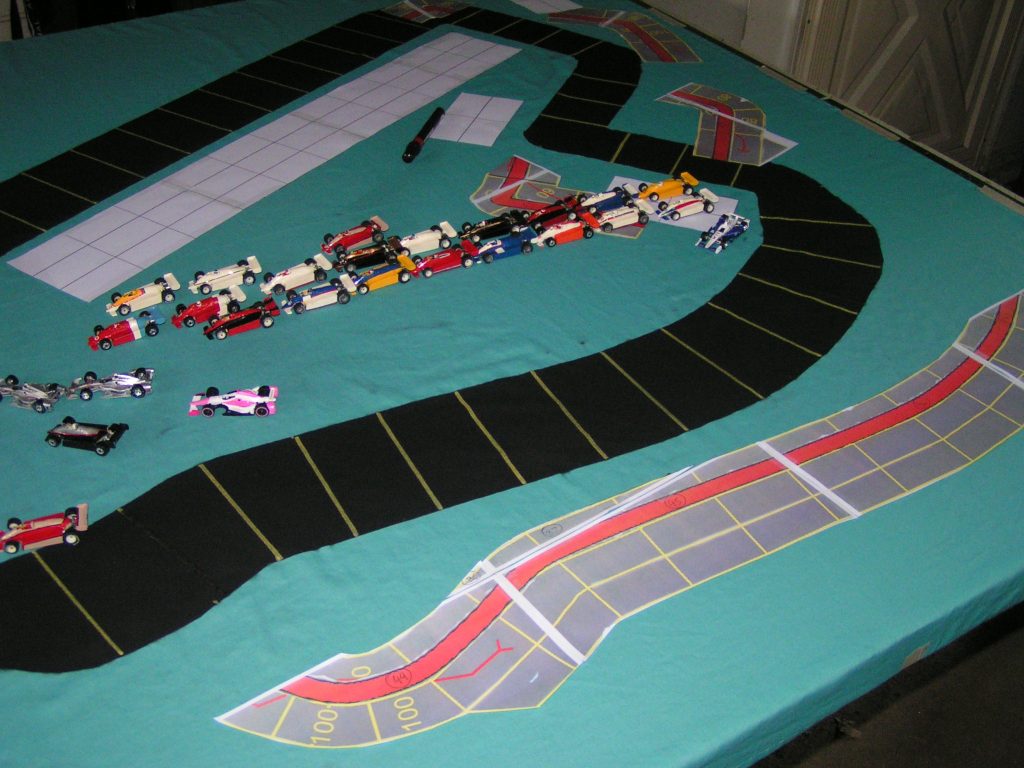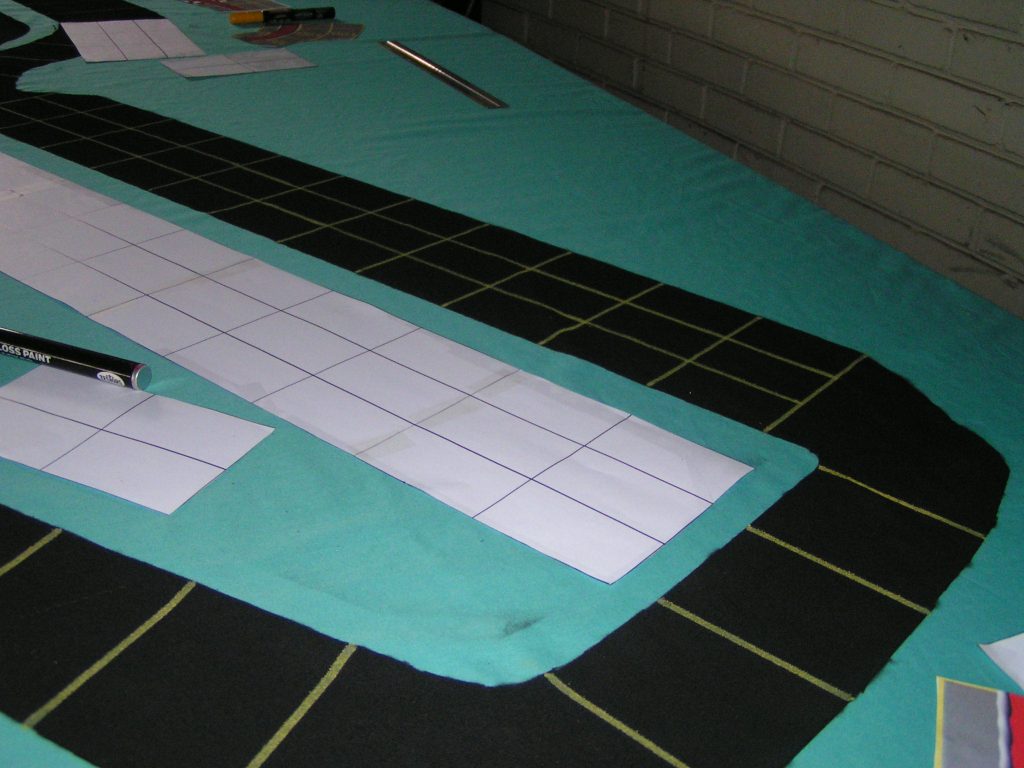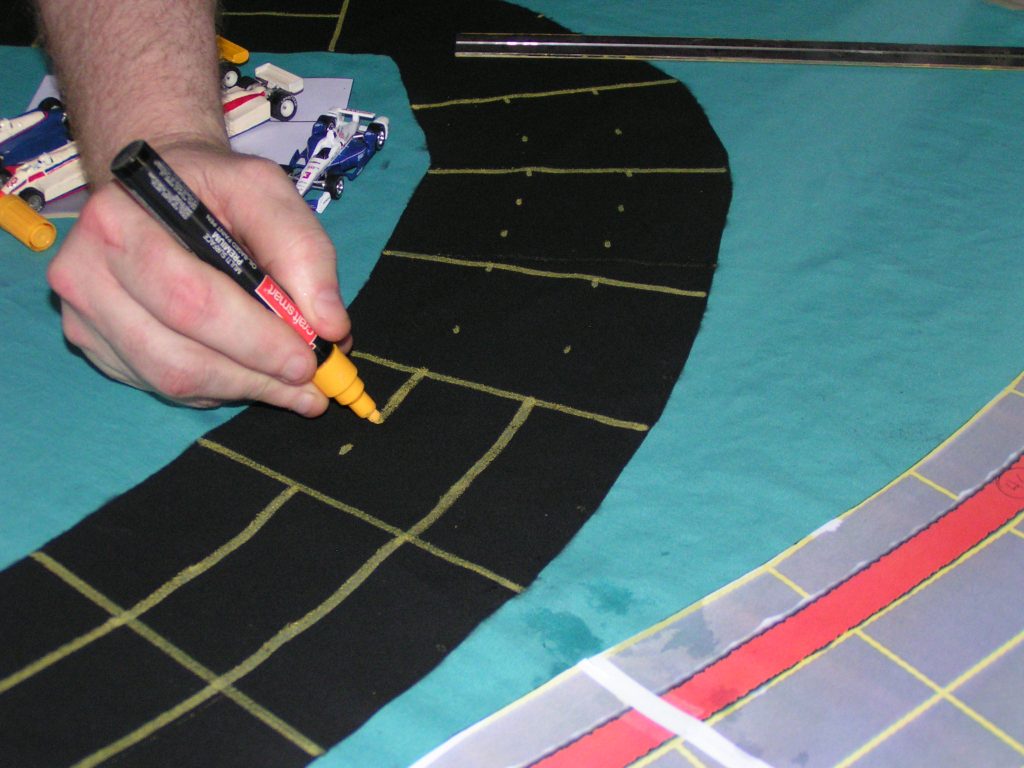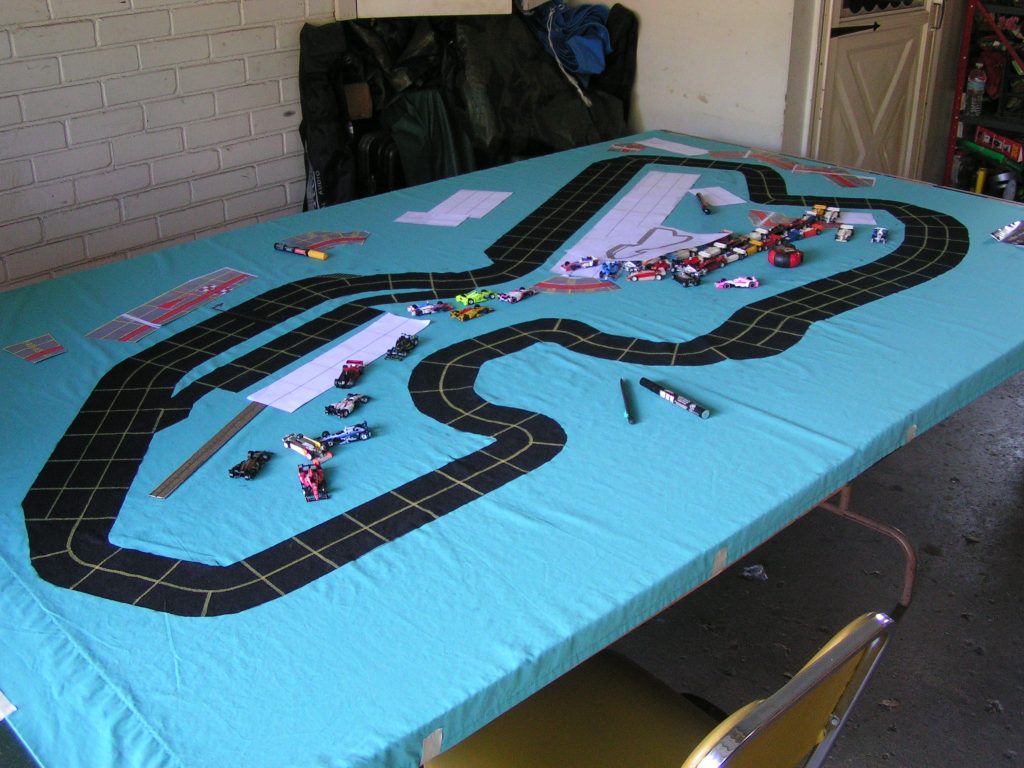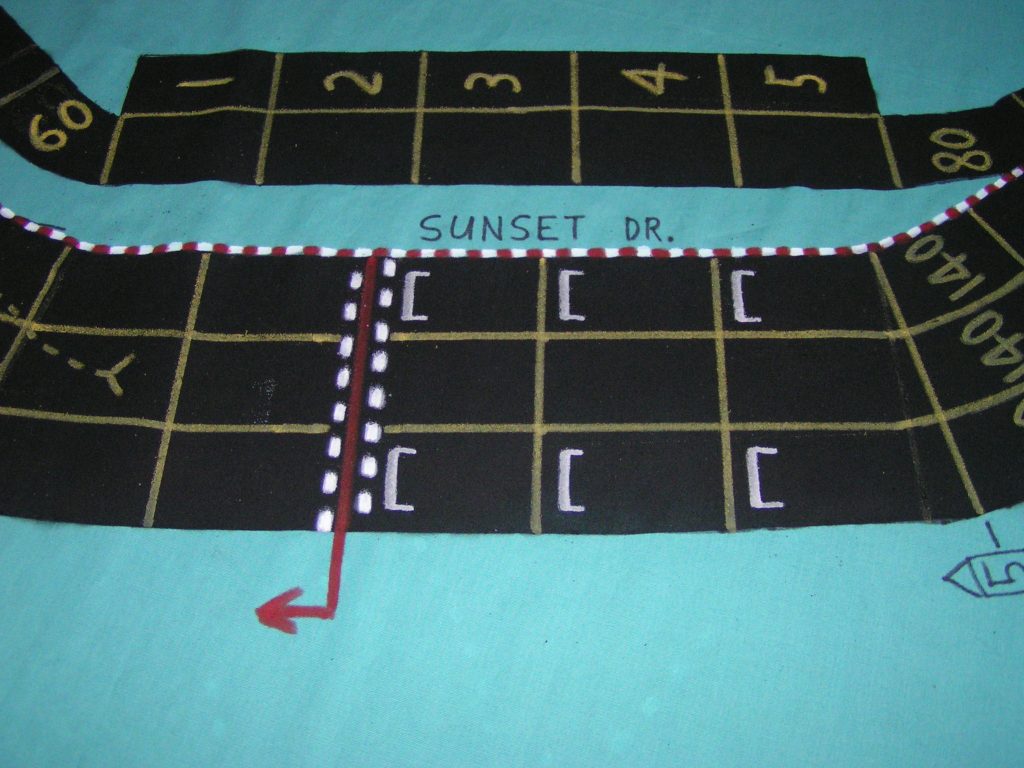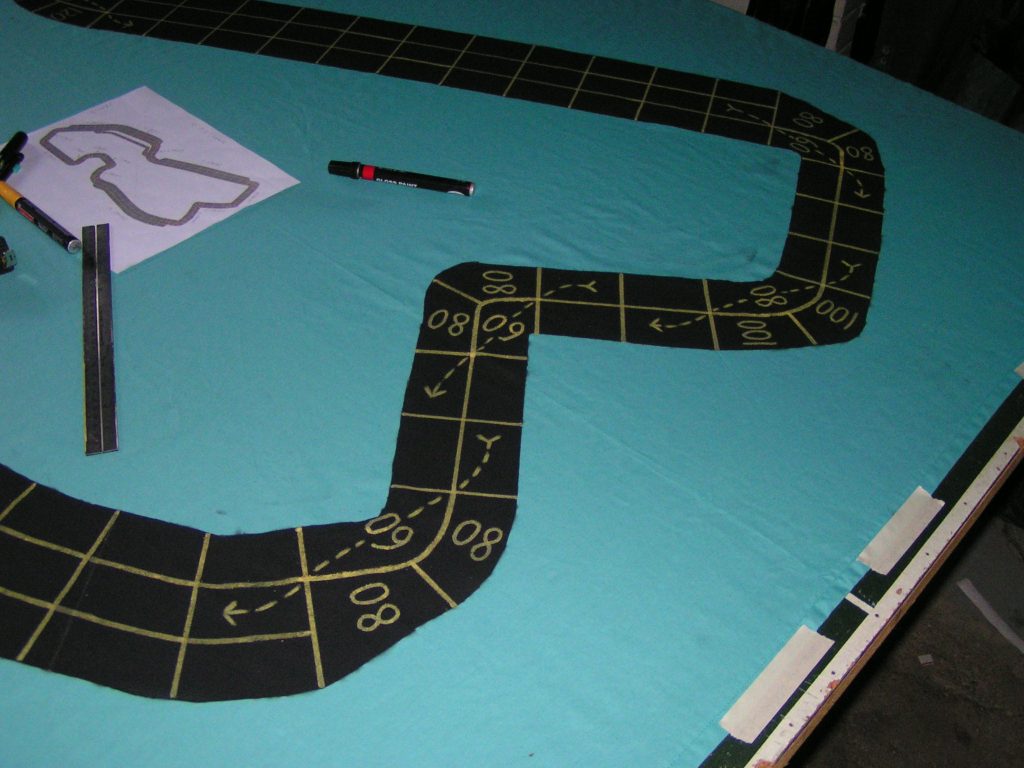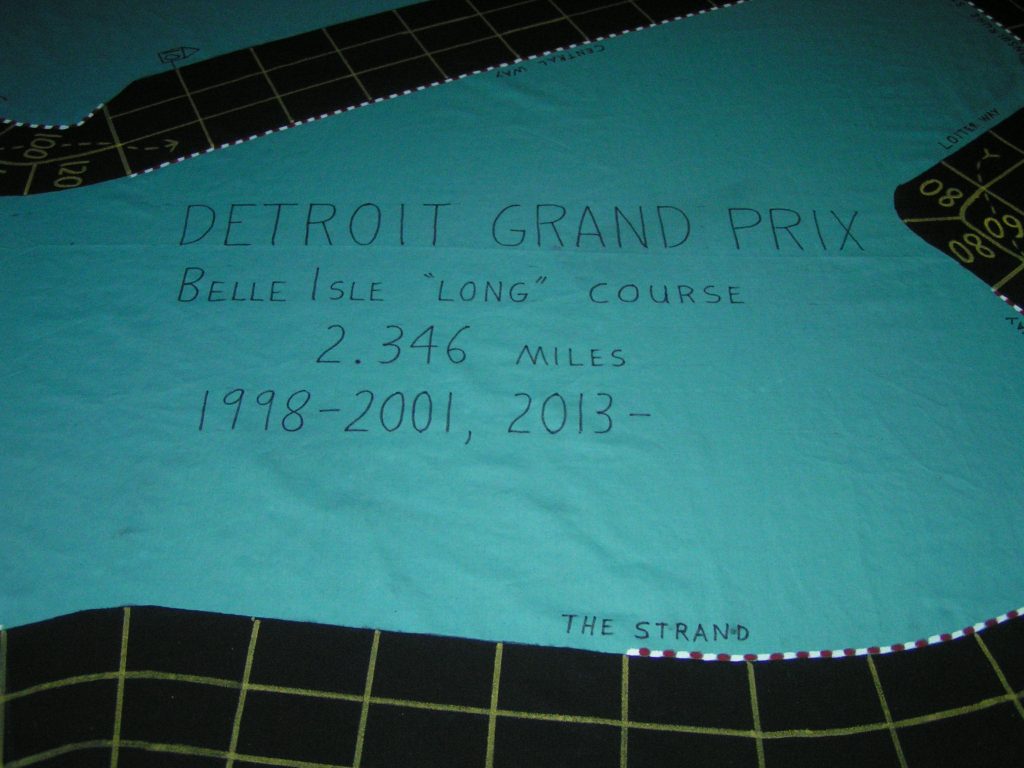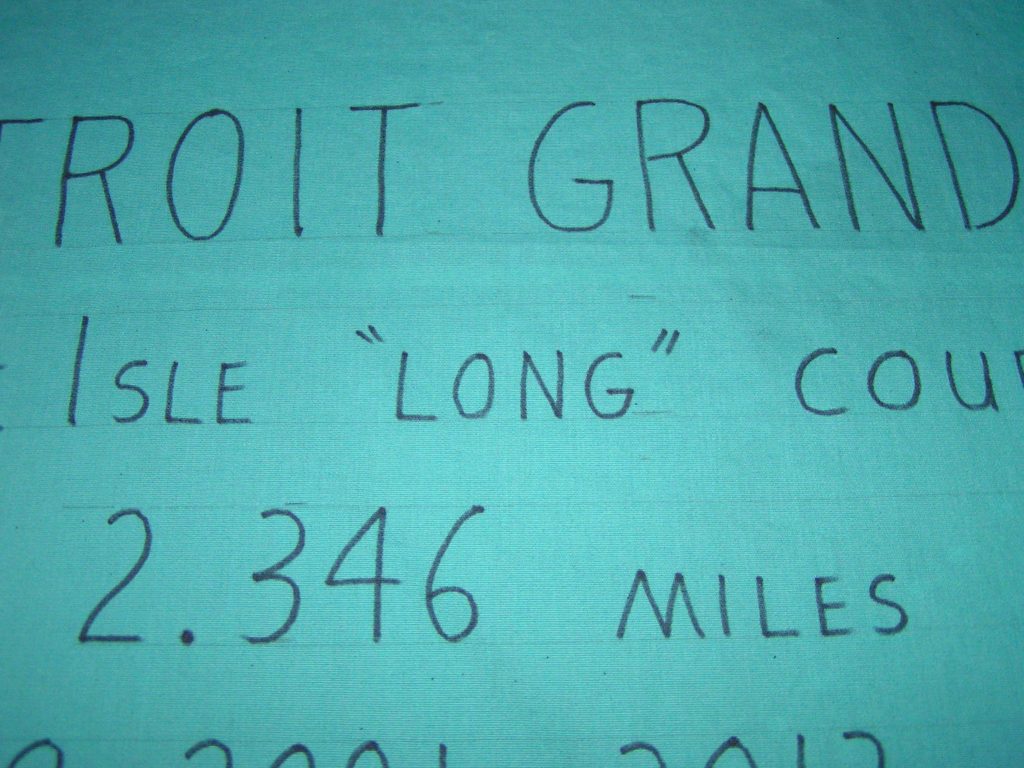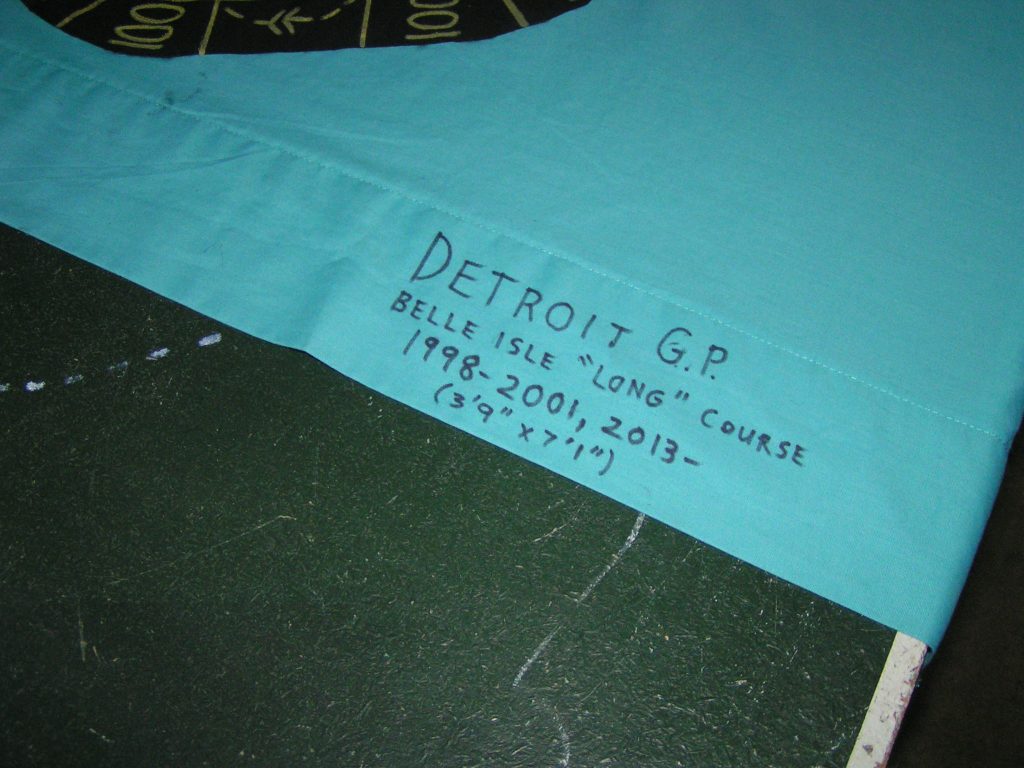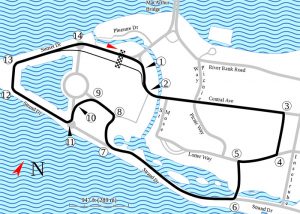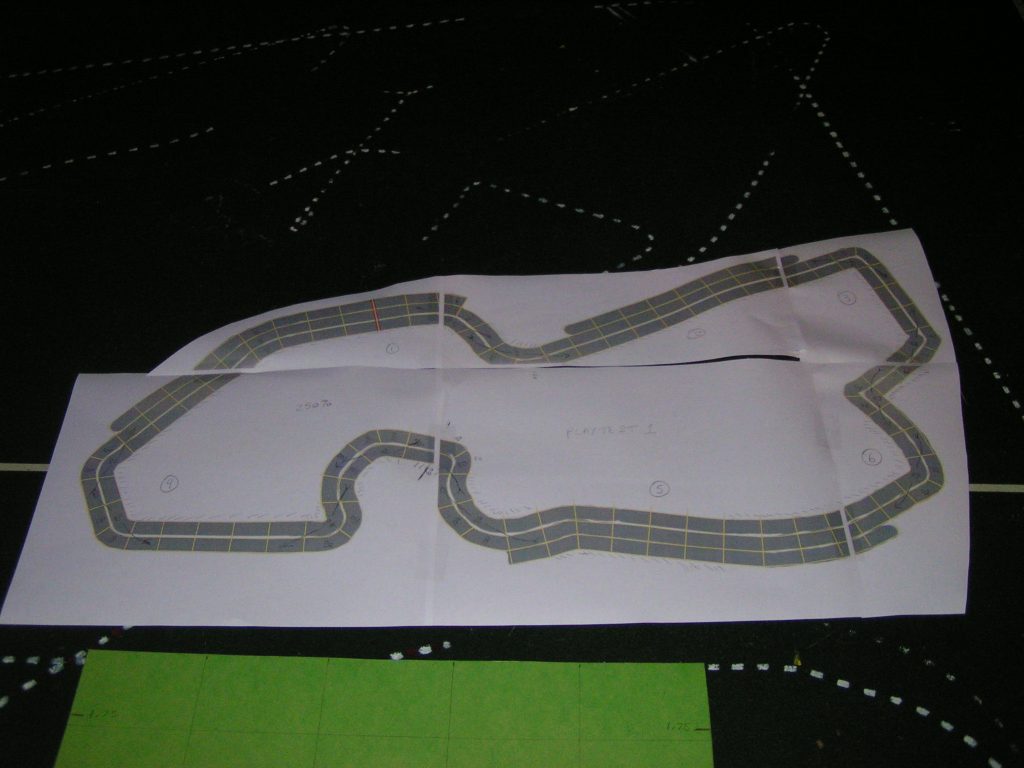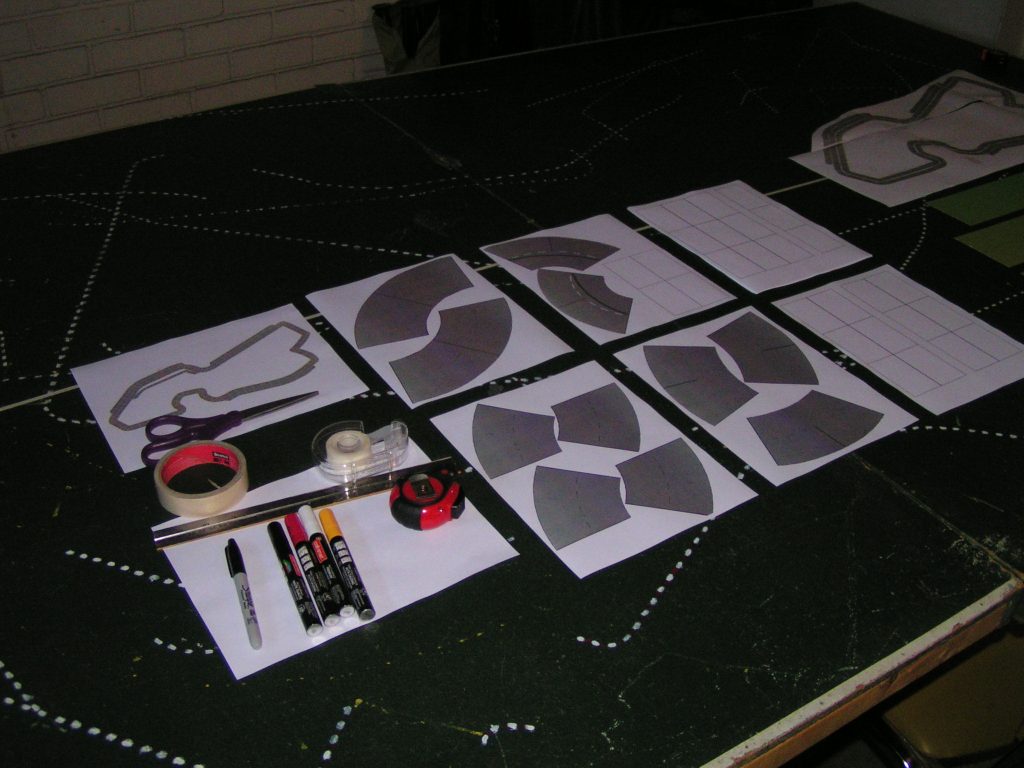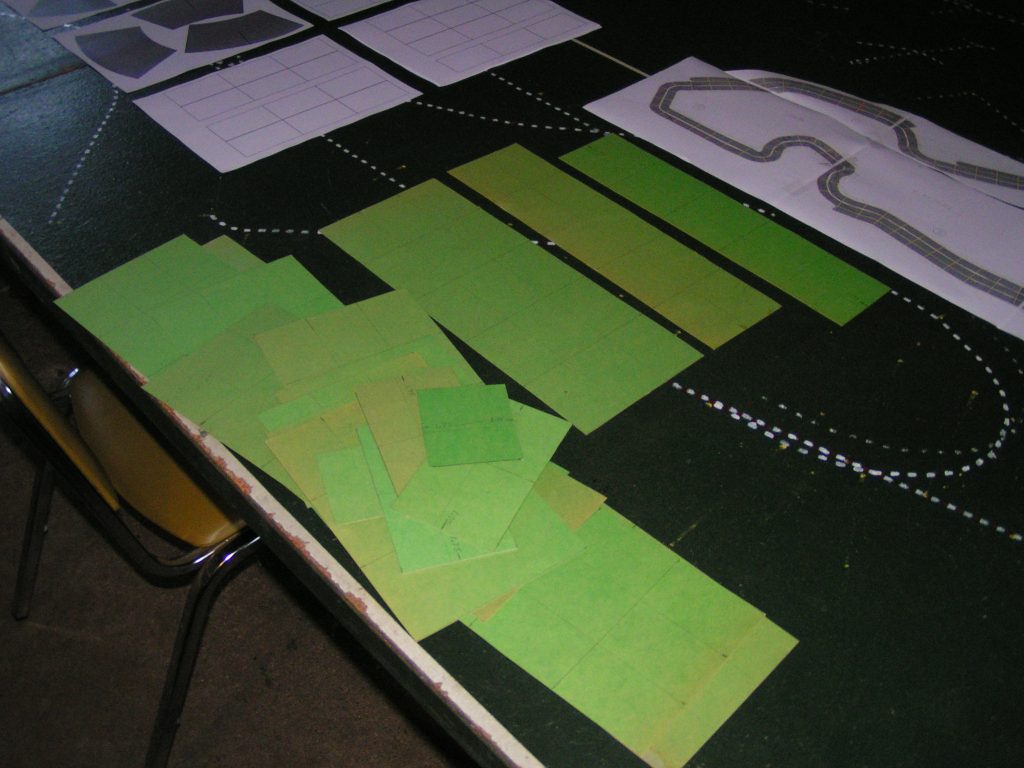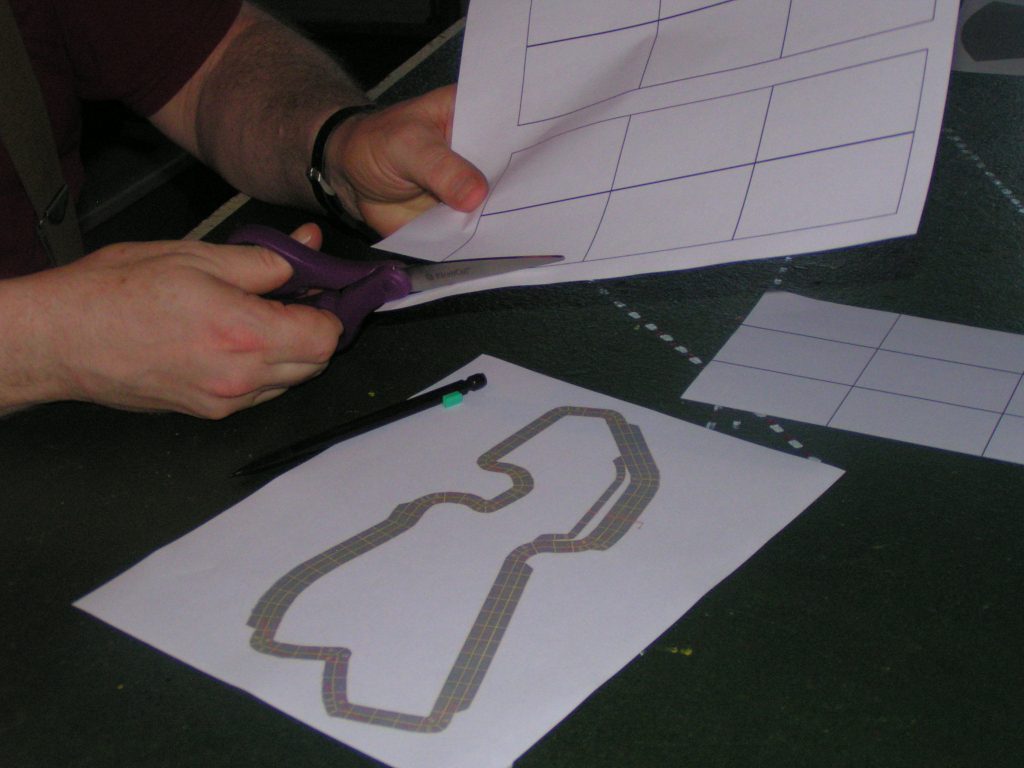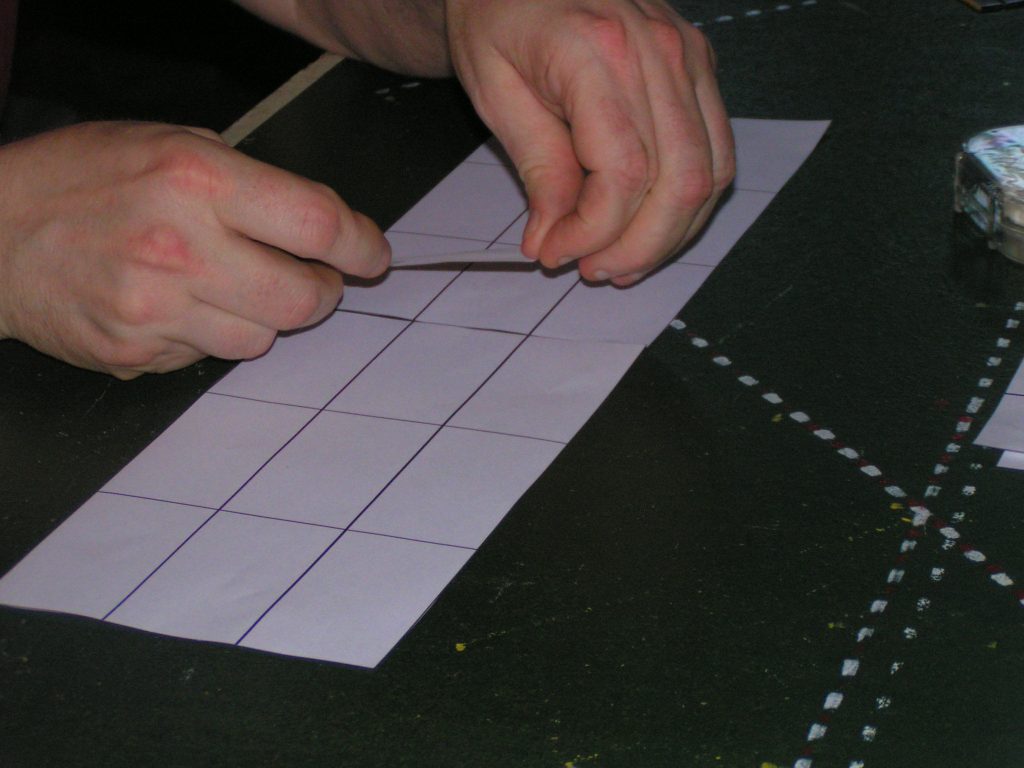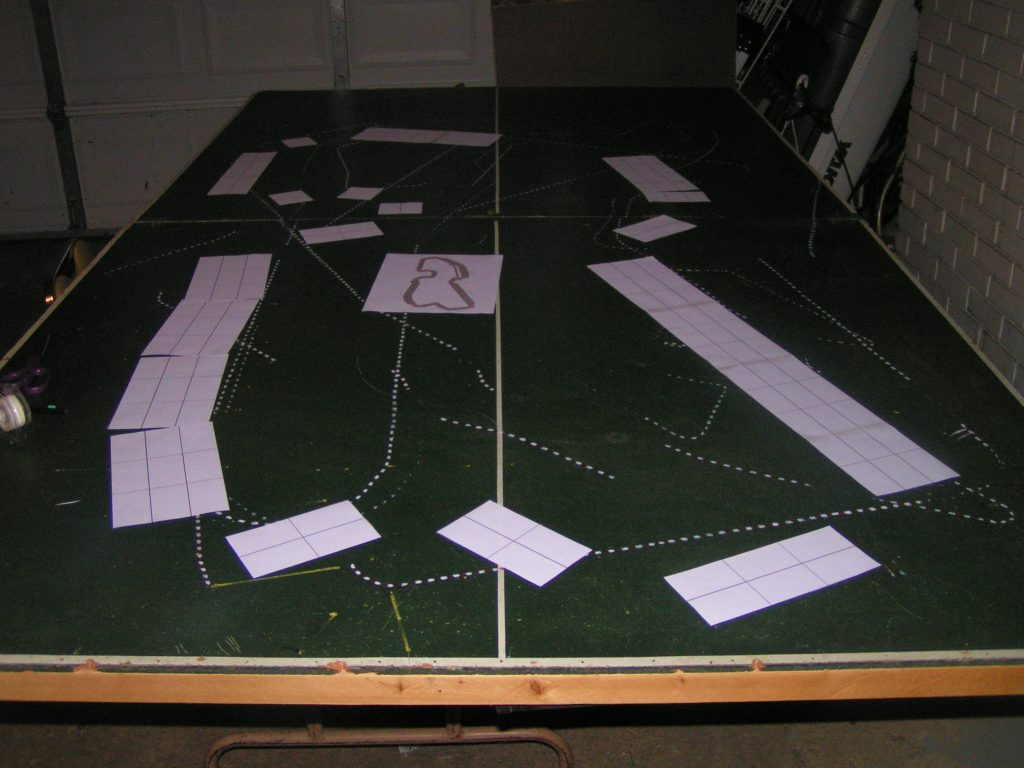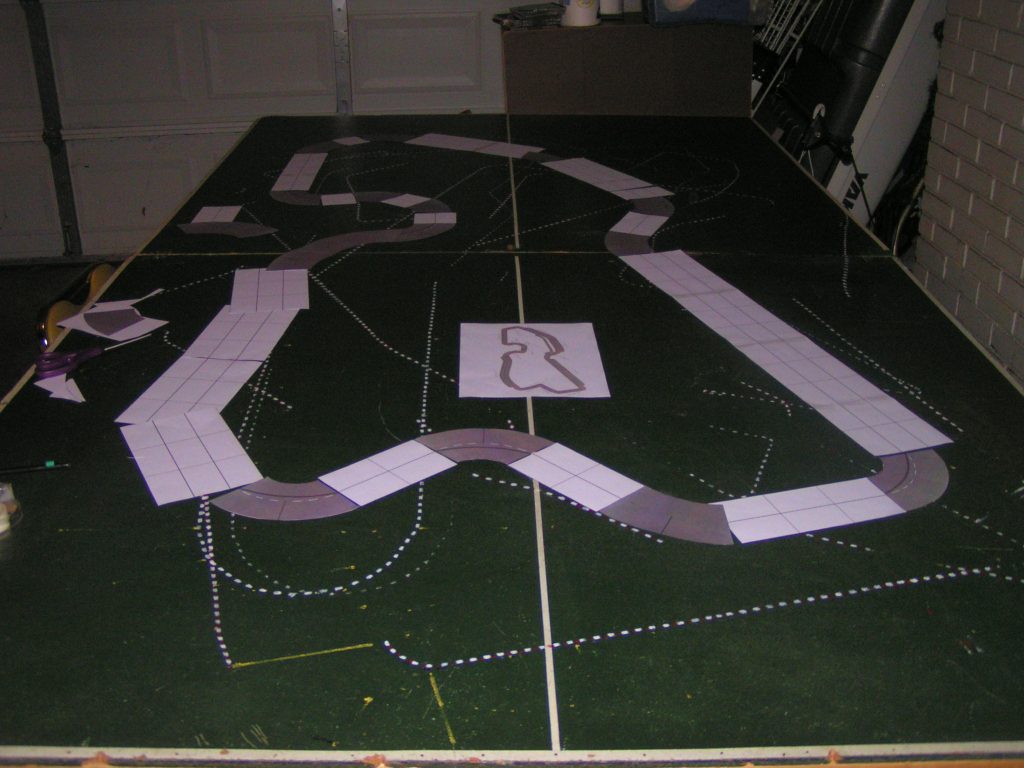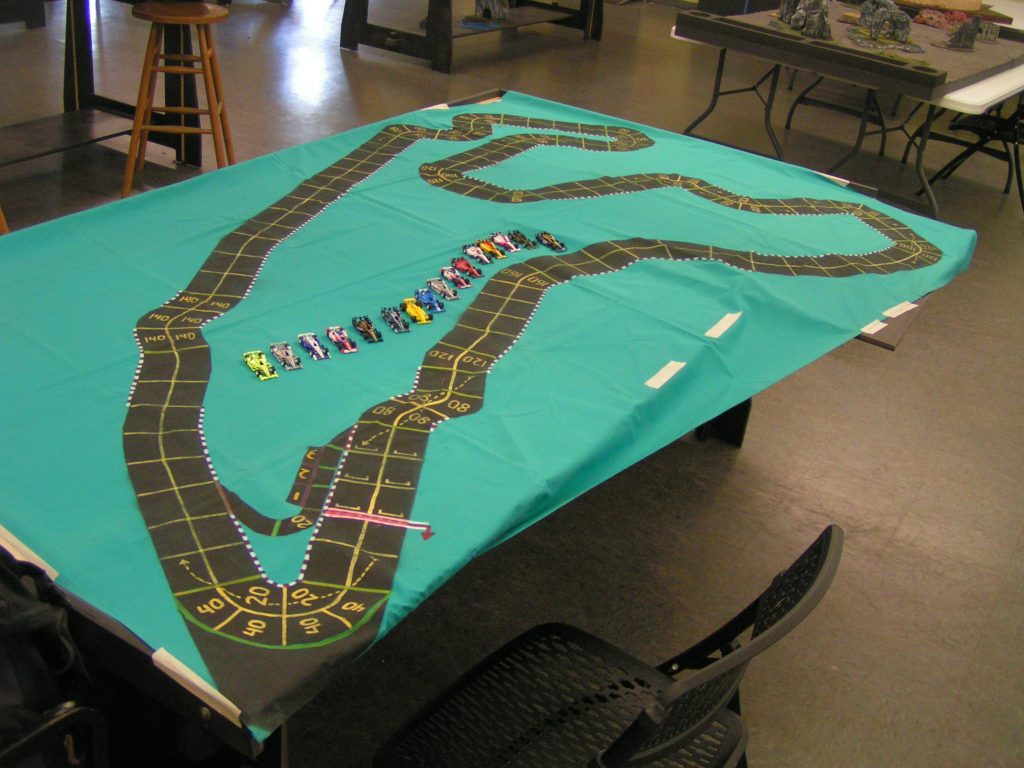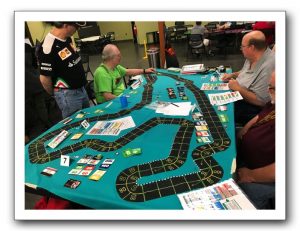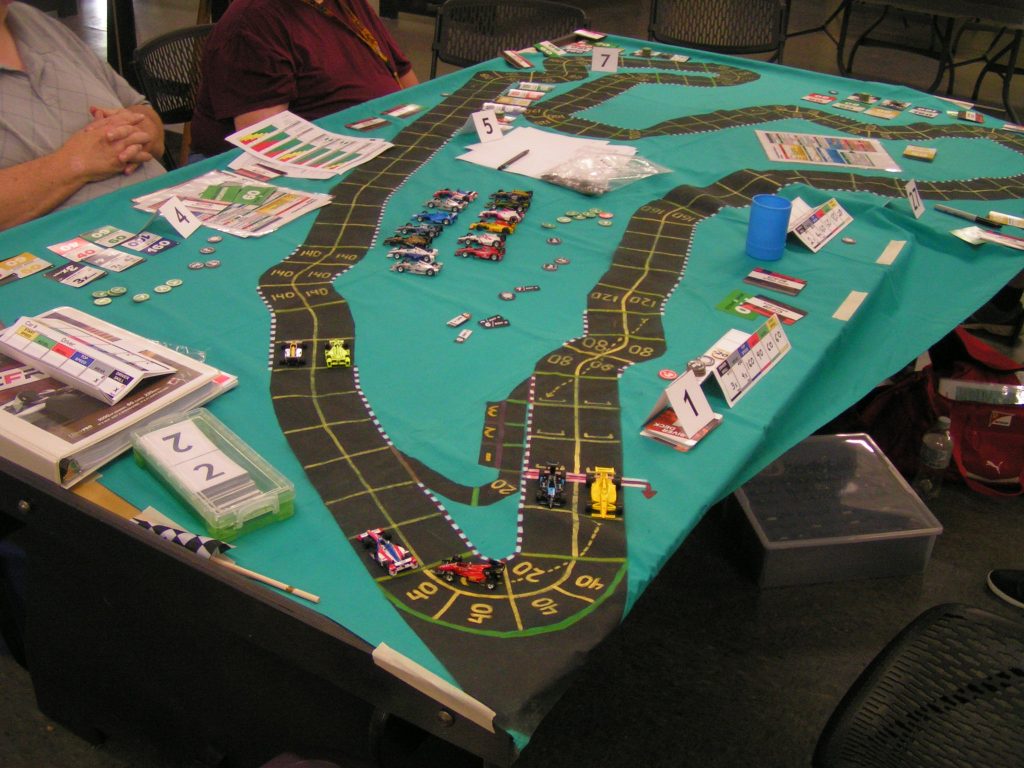After several months of running demo races in various locations to try to attract as many potential drivers as possible, the Championship Formula Racing-Detroit group started off their 2017-2018 series of races with the Italian Grand Prix on Friday, September 9, 2017. Ten drivers competed in the race, and when all was said and done, Jack Beckman won the race, followed by other podium finishers Richard White and Jim Landis. The race was at the Guild of Blades game store in Clawson, Michigan.
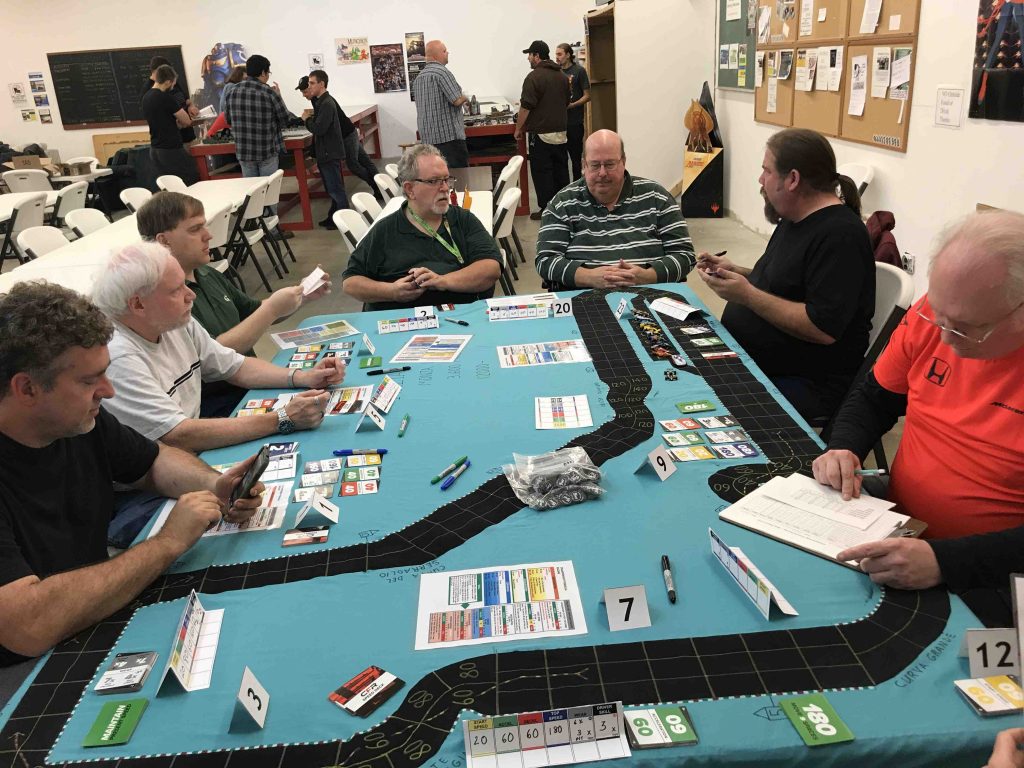
Drivers set up their cars preparatory to racing on the Monza, Italy track with 1:64 scale race cars. Pictured are (left-to-right): Richard White; Brian Robinson; Mike Cook; Jim Robinson; Jim Landis; Russ Herschler; and Garry Kaluzny.
In our former racing game campaign using Advanced Speed Circuit rules, we used to actually run our cars on qualifying laps; however, in the new CFR rules, starting positions are determined by “bidding” some of your car’s Wear and/or Skill markers. Mike Cook took the pole position with a bid of 8 Skill, which is equal to 4 Wear (for a bid total of 4). Jim Landis started in the other front row position with a bid of 3. The 2nd row starters were Garry Kaluzny and Brian Robinson with bids of 2.5 and 2, respectively. Gary Sturgeon bid 1 to start 5th, and Jack Beckman bid 0.5 to start 6th. The final four starters each bid nothing, so they rolled dice for their starting positions, with the highest dice rolls starting in front of the lower dice rolls. Greg Lim started 7th; Russ Herschler started 8th; Richard White started 9th; and Jim Robinson started 10th.
The starting grid with their car specs:
# Driver Start/Accel/Decel/Top/Wear/Skill/Tires 11 Mike Cook (Lotus) 20 60 60 180 3x 3x hard 20 Jim Landis (Benetton) 100 40 40 160 5x 2x soft 9 Garry Kaluzny (McLaren) 20 60 60 180 3x 3x soft 5 Brian Robinson (Walker Racing) 20 60 60 180 3x 3x soft 12 Gary Sturgeon (John Player) 60 60 60 160 4x 2x hard 3 Jack Beckman (Ferrari) 20 80 60 160 4x 2x hard 7 Greg Lim (Motorola) 20 80 60 160 4x 2x hard 23 Russ Herschler (Minardi) 60 60 40 160 4x 3x hard 1 Richard White (Brabham) 60 40 40 160 4x 4x hard 2 Jim Robinson (Williams) 60 40 40 180 4x 3x hard
Start = Start Speed (in miles/hour); Accel = Acceleration (in mph); Decel = Deceleration (in mph); Top = Top Speed (in mph); Wear = # of Wear markers; Skill = # of Skill markers.
We raced using the CFR rules for pit stops and different tire compounds. That meant that cars started with less Wear than if we were not using the pit stop rules. Since we raced three laps around the Monza track, cars with 3x Wear started with 3 x 3 = 9 Wear; cars with 4x Wear started with 4 x 3 = 12 Wear, and cars with 5x Wear started with 5 x 3 = 15 Wear. Cars would also have to make at least one pit stop during the race, as each car had to use both the hard and the soft tires. The CFR rules handle the different tires pretty eloquently; if your car is on hard tires, if you pass the finish line without stopping in the pits, you regain some Wear. This simulates that the hard tires don’t wear out as fast as the soft tires. A car on hard tires with 3x Wear would regain 4 Wear when crossing the finish line (except at the start or the finish of the race); a car with 4x Wear would regain 3 Wear when crossing the line, and a car with 5x Wear would regain 2 Wear when crossing the line.
Soft tires don’t allow cars to regain Wear, but they do allow drivers to spend Wear in extra ways. For example, drivers could spend 3 Wear if they were going 60 mph over the Speed Limit in a corner. Cars on hard tires (or using the basic rules without pit stops) would have to use 2 Wear and roll dice to take a chance of spinning out or crashing when 60 mph over the speed limit in a corner. Soft tires also allow drivers to increase their starting speed without chancing a stall, and they also allow using a Wear to increase Acceleration by 20 mph in a turn.
Drivers starting on soft tires were Jim Landis, Garry Kaluzny, and Brian Robinson. Everyone else started on hard tires. All of the soft tire cars increased their start speed by 20 mph, so that allowed Jim Landis to start at 120 mph, and he quickly jumped in front of the field at the start.
At the first turn (the Variante del Rettifilo), Jim Landis led, followed by Garry Kaluzny, Richard White (rocketing from 9th on the grid to 3rd on the start), Russ Herschler, Brian Robinson, Mike Cook (the pole-sitter), Gary Sturgeon, Jack Beckman, Jim Robinson, and Greg Lim. Going through the del Rettifilo turn, Brian Robinson managed to get by Russ Herschler. At the Variante Ascari (the series of corners leading onto the back straightaway), Jim Landis was leading Garry Kaluzny by 4 spaces on the track, followed by Jack Beckman and Brian Robinson (each 5 spaces behind Landis), then came White and Herschler (each 7 spaces behind Landis), then Cook (8 spaces back), Sturgeon (12 spaces back), Jim Robinson (16 spaces back), and Lim (22 spaces back). But then going through Ascari, both Herschler and Jim Robinson spun, so they dropped back in the field.
As the cars came around the final turn of the first lap, the Curva Parabolica, the three cars on soft tires, Landis, Kaluzny, and B. Robinson, all pitted as they had all burned through all of their starting wear. A bit of a surprise was when Sturgeon also pitted to switch from hard to soft tires. Herschler also pitted to switch from hard to soft tires.
The official order after the 1st lap was complete was: Beckman (+5); White (+7); Cook (-2); Sturgeon (+1, pitted); Landis (-3, pitted); Herschler (+2, pitted); Lim (0); Kaluzny (-5, pitted); B. Robinson (-5, pitted); and J. Robinson (0). The + or – symbols tell how many spaces the driver improved (+) their lap 1 position from their starting position, or how many spaces they lost (-) from their starting position.
On the 2nd lap, just past the del Rettifilo corner, Gary Sturgeon in the John Player car forced a pass on Garry Kaluzny’s McLaren in the Curva Grande, although Sturgeon had to burn a Wear when the cars bumped together. Jim Robinson spun a second time, this time at del Rettifilo, the sharp right-hand corner at the end of the main straightaway. He also had failed his deceleration dice roll just before spinning, so his brakes were just not up to snuff on this day. Russ Herschler, who had just come out of the pits, was able to pass J. Robinson before Robinson’s car got up to speed again.
As the cars passed through the Ascari corners on the 2nd lap, it was Beckman, White and Cook with quite a lead over the other drivers. Landis was in 4th place, 12 spaces behind the top three cars. Although, Landis had pitted on the 1st lap, and the three leaders had not yet ventured into the pits.
As the leaders passed through the final turn, the Curva Parabolica, on lap 2, the cars which had not stopped in the pits on after 1st lap did now pull into the pits. Cars that pitted on this lap were Beckman, White, Cook, Lim, and Jim Robinson, and they all switched from hard to soft tires. The other cars stayed out on the track.
The official order after lap 2 was: Landis (+4), Beckman (-1, pitted), White (-1, pitted), Lim (+3, pitted), Cook (-2, pitted), Kaluzny (+2), Sturgeon (-3), B. Robinson (+1), Herschler (-3), J. Robinson (0, pitted). The + or – symbols indicate how many positions the driver gained or lost from their position at the end of lap 1.
Early in the 3rd lap, three drivers, Beckman, Landis, and White, were side-by-side going into the Variante del Rettifilo. Landis and White blinked first, and Beckman’s Ferrari surged into the lead and got through that corner first. Beckman continued to lead through the first of the two Lesmo corners, building a 4-space lead.
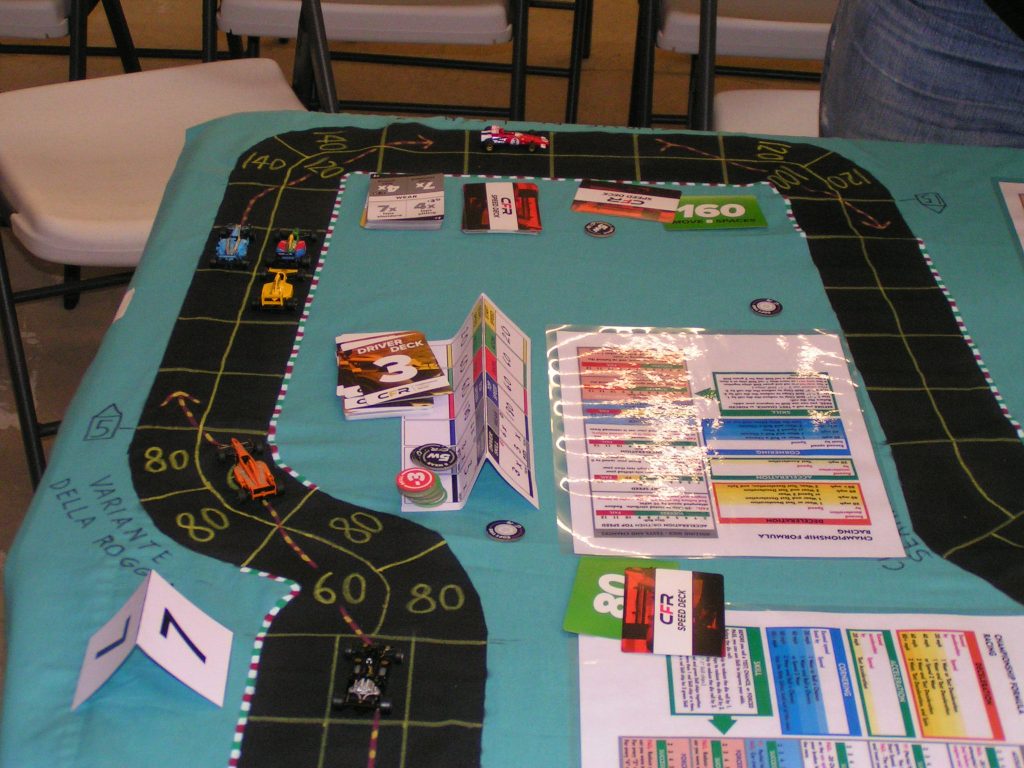
Beckman’s Ferrari leads the last lap through the Lesmo curves, followed by Landis, White, Cook, Kaluzny, and Sturgeon.
Richard White made a valiant effort to catch Beckman, but the engine in White’s Brabham started going sour as he approached the Ascari corners for the last time, and so could not catch up. Soon after that, Herschler’s Minardi spun in the 2nd Lesmo corner, although that didn’t affect his 9th place at the time.
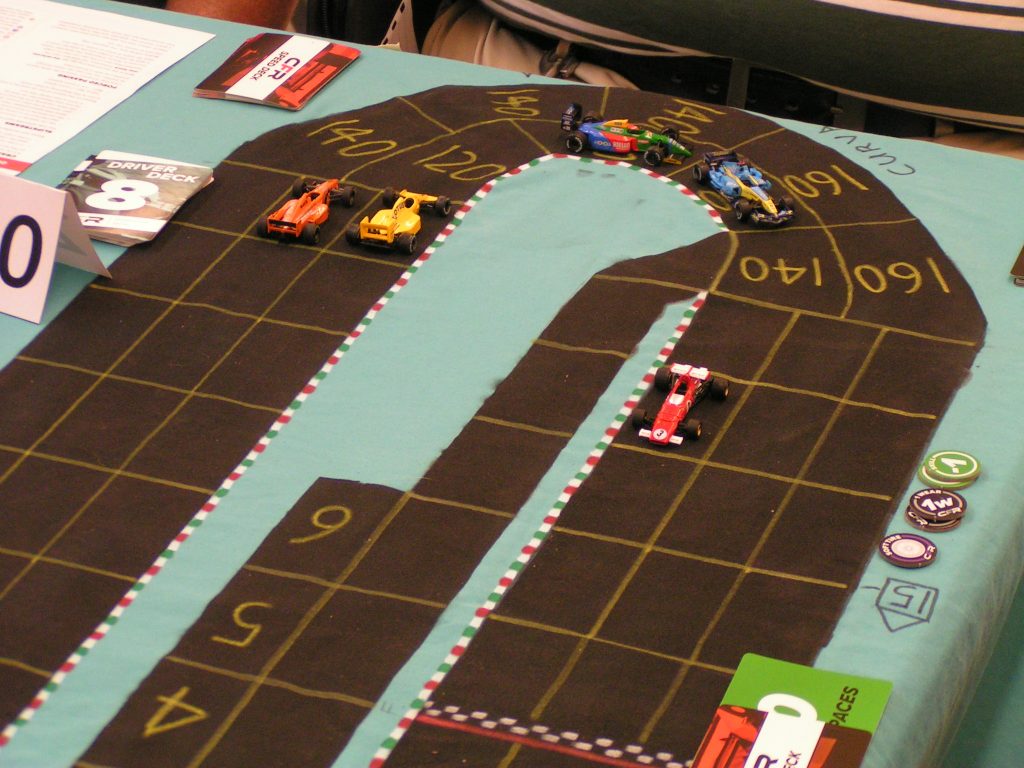
Beckman’s Ferrari about to cross the finish line. White and Landis trail, and Cook (yellow car) and Kaluzny (orange car) are side-by-side going into the Parabolica.
Going through the Curva Parabolica for the last time, Jack Beckman had no trouble motoring across the finish line first, thusly winning the inaugural race of the CFR-Detroit race series. Richard White was able to hold off Jim Landis for 2nd. The duel for 4th place was decided with Garry Kaluzny barely holding off Mike Cook. Exiting the Parabolica, Cook was right behind Kaluzny, ready to use two bonus spaces for drafting Kaluzny, which would have allowed Cook to pass Kaluzny for 4th. However, Kaluzny’s engine didn’t like being pushed to 200 mph, and spurted some oil onto the track. Cook had to swerve to avoid the oil, thus missing the slingshot move, and so finished 5th. Brian Robinson grabbed the last points-paying position in 6th place, and then 7th through 10th places went to Gary Sturgeon, Greg Lim, Russ Herschler, and Jim Robinson.
Place Driver Points
1 Jack Beckman (Ferrari) (+5) - 10 points
2 Richard White (Brabham) (+7) - 6 points
3 Jim Landis (Benetton) (-1) - 4 points
4 Garry Kaluzny (McLaren) (-1) - 3 points
5 Mike Cook (Lotus) (-4) - 2 points
6 Brian Robinson (Walker Racing) (-2) - 1 point
7 Gary Sturgeon (John Player) (-2)
8 Greg Lim (Motorola) (-1)
9 Russ Herschler (Minardi) (-1)
10 Jim Robinson (Williams) (0)
The + and – indicates how many places the driver gained or lost from their qualifying position. Jack Beckman gained 5 places from his starting position, although Richard White gained 7 places. Both drivers drove very fine races. They were the only two drivers who improved upon their starting position.
Very surprisingly, all 10 drivers who started the race also finished the race. This may be the only time this has occurred in the history of the Detroit area Speed Circuit/CFR races! Richard White stated that he thought that this was the only time when every starter also finished the race.
The next race will be on the 2010/2011 version of the Silverstone, England track. Race day is Friday, October 13, starting at 7:00 pm. The race venue has yet to be determined.
